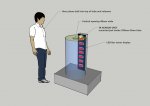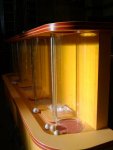colinsmurph
New Member
Hi, this is my 1st post so please try and put up with me if it sounds a littel stupid.
I need to sense ball beeing droped past a known point and trigger a light sequence, hold the end of the sequence for time X or untill another wooden ball is droped.
The system may also have a "sleep mode" where another light sequence may need interupting by reading the IR...
I have to use a IR distance sensor mounted at the top of a 250mm diameter perspex tube to sense a 30mm wooden ball falling past (i was considering using the Sharp GP2D120)
I am concerned that If i simply look for the IR voltage to be > X I may miss the event while the wait comands, and or light sequence's are active and IR is not currently beeing monitored.
I have ordered my 1st ever Picaxe, 28x1 and hope to use it for this project.
Thanks in advance for any help!!
I need to sense ball beeing droped past a known point and trigger a light sequence, hold the end of the sequence for time X or untill another wooden ball is droped.
The system may also have a "sleep mode" where another light sequence may need interupting by reading the IR...
I have to use a IR distance sensor mounted at the top of a 250mm diameter perspex tube to sense a 30mm wooden ball falling past (i was considering using the Sharp GP2D120)
I am concerned that If i simply look for the IR voltage to be > X I may miss the event while the wait comands, and or light sequence's are active and IR is not currently beeing monitored.
I have ordered my 1st ever Picaxe, 28x1 and hope to use it for this project.
Thanks in advance for any help!!


